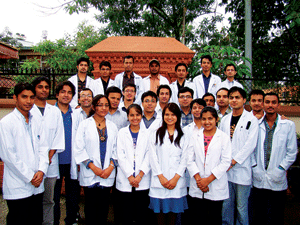Optometry in Nepal
Sight Gags by Scott Lee, OD

Editor’s note: This letter, written by an optometry student in Nepal, provides US optometrists with a perspective on optometric professional status in a very different country.
The only optometry program in the country of Nepal is run at the Institute of Medicine, in Kathmandu, in collaboration with the University of Auckland, New Zealand. This is a four-year bachelor’s program that began in 1998 and has graduated 70 optometrists to date—the sum total of optometrists in Nepal. The institute is now having a greater impact than ever.
The first year consists of basic sciences. The second and third years consist of rigorous clinical hours, including special clinics such as glaucoma, neuro-ophthalmology, retina, contact lenses, low vision, etc. The final year consists of a thesis, as well as two months of [internship] and one month of community diagnosis. Also, PowerPoint presentations are conducted every morning before the start of outpatient rounds.
Many graduating optometrists enter into private practice, while some work in hospitals or opt for further education. Currently, Nepal is short of an estimated 534 optometrists, according to “Mid Term Review of Vision 2020: The Right to Sight, Government of Nepal 2011.” Regarding the investment and the course of study, annual income of an optometrist is $3,000 [in US dollars] on average, which in comparison to other health professionals in Nepal is quite low.
Some of the major [professional] constraints faced by optometrists right now include confinement of optometrists as refractionists in hospitals, shortage of diagnostic instruments in private practice, and fewer chances of scholarship outside the country for further studies.
However, optometrists are well equipped to play a major role as front line eye care practitioners. But perception among other specialists, such as ophthalmologists, neurologists, pediatricians and general physicians, is quite variable. They are unaware of the role an optometrist can play in the multispecialty consultation and as a primary eye care physician.
Due to the lack of an optometry council, optometrists are registered with the Nepal Health Professional Council, a government organization, before starting professional life. The Nepalese Association of Optometrists (NAO), a self-regulating body established to accredit practitioners against a set of guidelines, passed a code of ethics in 2011 and has started administering a licensing examination to regulate the profession.
The NAO faces several challenges, such as establishing a peer review optometry council of Nepal, actively lobbying the government to obtain independent status for optometry, creating public awareness about optometry and its contribution to society, and opening a new optometry school with a common minimum optometry curriculum to meet the increasing demand.
Uncorrected refractive error being the major cause of visual impairment in the world and the integration of eye health into general health now on anvil, optometrists in Nepal are in a pivotal state of bearing huge responsibility to provide comprehensive eye and vision care at all levels, freeing up ophthalmologists for surgery and treatment of complex cases. This, ultimately, plays a vital role in inter-professional communication through a common referral system.

Optometry students and faculty at the Institute of Medicine, in Kathmandu, Nepal.
[Editor’s note: Nepal currently has only 150 ophthalmologists serving a population of nearly 27 million.]
In Nepal, optometry is in its adolescence and needs further regulation and standardization to fulfill the responsibilities bestowed upon it. Considering the primary access by the public, the skills and services provided by the optometrists, and the contribution to knowledge by optometric research, optometry must be considered an independent profession and be afforded an independent government-controlled council, such as those of pharmacy and dentistry.
The optometrist, being the first line of contact in eye care, must be legislated to work independently in order to provide essential eye care services across the country to detect various systemic diseases in the population and to work in collaboration with ophthalmologists and other medical and rehabilitation professionals.
Some of our graduates are pursuing higher degrees at several world-renowned universities in eye care, such as SUNY College of Optometry in New York, University of New South Wales and Flinders University in Australia, London School of Hygiene and Tropical Medicine in the UK, and the University of Auckland in New Zealand. But due to poor job security, low incentives, a shortage of facilities and a lack of opportunities in the research field in Nepal, these optometrists are facing a hard time returning to their own country.
—Sudarshan Khanal, fourth-year student
Bachelor of Optometry, Institute of Medicine, Kathmandu, Nepal
More Medical Model Muddle Trouble
First, I want to thank Dr. Brittany Schauer for proving that someone actually reads the Letters to the Editor column. (
“Medical Model Muddle Rebuttal,” December 2012.) I was beginning to think otherwise, as her rebuttal is the only indication that anyone actually read either of my two published letters.
Second, it is a bit discouraging to realize that I am such a poor communicator. The sole purpose of my letter was not to belittle recent and current optometry school graduates, but quite the opposite. It’s my opinion that someone who graduates from a med school should be awarded a medical degree, i.e. Brittany G. Schauer, OD, should really be Brittany G. Schauer, MD. Any anyone who doesn’t agree that the MD degree is far more prestigious is not bright enough to own either degree.
Lastly, I am guilty of a poor word choice in suggesting we convert optometry schools into med schools. Apparently that already has been done. All that’s required is just renaming or rebranding.
Thanks again Dr. Schauer for reading the column.
—John Clark Moffett, OD
Dallas
To send a Letter to the Editor, e-mail Jack Persico, editor-in-chief,
[email protected], with “Letter to the Editor” as the subject line.

